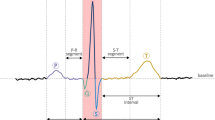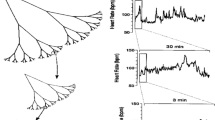Abstract
Heart rate signal can be used as certain indicator of heart disease. Spectral analysis of heart rate variability (HRV) signal makes it possible to partly separate the low-frequency (LF) sympathetic component, from the high-frequency (HF) vagal component of autonomic cardiac control. Here, we used two important features to characterize the nonlinear fluctuations in the heart variability signal (HRV): cardiac vagal index (CVI) and cardiac sympathetic index (CSI) which indicates vagal and sympathetic function separately. This article presents a methodology for analyzing the influence of CVI and CSI on heart rate variability spectral patterns—low-frequency (LF) and high-frequency (HF) spectral bands and LF/HF ratio. An adaptive neuro-fuzzy network is used to approximate correlation between these two features and spectral patterns. This system is capable to find any change in ratio of features and spectral patterns of heart rate variability signal (HRV) and thus indicates state of both parasympathetic and sympathetic functions in newly diagnosed patients with heart diseases.






Similar content being viewed by others
References
Zhong Y, Wang H, Ju KH, Jan KM, Chon KH (2004) Nonlinear analysis of the separate contributions of autonomic nervous systems to heart rate variability using principal dynamic modes. IEEE Trans Biomed Eng 51:255–262
Pan J, Tompkins JW (1985) A real-time QRS detection algorithm. IEEE Trans Biomed Eng 32:230–255
Malik M (1996) Heart rate variability: standards of measurement, physiological interpretation, and clinical use. Eur Heart J 17:354–381
Berntson GG, Bigger JT et al (1997) Heart rate variability: origins, methods, and interpretative caveats. Psychophysiology 34:623–648
Pincus MS (1991) Approximate entropy as a measure of system complexity. Proc Nat Acad Sci 88:2297–2301
Xinbao N, Chunhua B, Jun W, Ying C (2006) Research progress in nonlinear analysis of heart electric activities. Chin Sci Bull 51:385–393
Chunhua B, Xinbao N (2004) Nonlinearity degree of short-term heart rate variability signal. Chin Sci Bull 49:530–534
Mourot L, Bouhaddi M, Perrey S et al (2004) Quantitative Poincare plot analysis of heart rate variability: effect of endurance training. Eur J Appl Physiol 91:79–87
Lerma C, Infante I, Groves HP, Jose MV (2003) Poincare plot indexes of heart rate variability capture dynamic adaptations after haemodialysis in chronic renal failure patients. Clin Physiol Func Im 23:72–80
Addio GD, Pinna GD, Rovere MTL, Maestri R et al (2001) Prognostic value of Poincare plot indexes in chronic heart failure patients. Comput Cardiol 28:57–60
Chiu HW, Wang TH, Huang LC et al (2003) The influence of mean heart rate on measures of heart rate variability as markers of autonomic function: a model study. Med Eng Phys 25:475–481
Basano L, Canepa F, Ottonello P (1998) Real-time spectral analysis of HRV signals: an interactive and user-friendly PC system. Comput Methods Programs Biomed 55:69–76
Wu GQ, Arzeno MN, Shen LL et al (2009) Chaotic signatures of heart rate variability and its power spectrum in health, aging and heart failure. PLoS One Public Library Sci 4:2
Busek P, Vankova J, Opavsky J et al (2005) Spectral analysis of heart rate variability in sleep. Physiol Res 54:369–376
Groome JL, Mooney MD, Bentz SL, Singh PK (1994) Spectral analysis of heart rate variability during quiet slep in normal human fetuses between 36 and 40 weeks of gestation. Early Hum Dev 38:1–10
Colak HO (2009) Preprocessing effects in time-frequency distributions and spectral analysis of heart rate variability. Dig Sig Proc 19:731–739
Khandoker AH, Jelinek HF, Moritani T, Palaniswami M (2010) Association of cardiac autonomic neuropathy with alteration of sympatho-vagal balance through heart rate variability analysis. Med Eng Phys 32:161–167
Toichi M, Sugiura T, Murai T, Sengoku A (1997) A new method of assessing cardiac autonomic function and its comparision with spectral analysis and coefficient of variation of R-R interval. J Aut Nerv Syst 62:79–84
Lin CW, Wang JS, Chung PC (2010) Mining physiological conditions from heart rate variability analysis. IEEE Comput Intell Mag 5:50–58
Apfelbaum JD, Caravati EM, Kerns WP, Bossart PJ, Larsen G (1995) Cardiovascular effects of carbamazepine toxicity. Ann Emerg Med 25:631–635
Meneses ASJ, Moreira HG, Daher MT (2004) Analysis of heart rate variability in hypertensive patients before and after treatment with angiotensin II-converting enzyme inhibitors. Arquivos Brasileros de Cardiologia 83:169–172
Lado MJ, Vila XA, Rodrigez LL, Mendez AJ, Olivieri DN, Felix P (2009) Detecting sleep apnea by heart rate variability analysis: assessing the validity of databases and algorithms. J Med Syst 33:1–9
Persson H, Ericson M, Tomson T (2007) Heart rate variability in patients with untreated epilepsy. Seizure 16:504–508
Hallioglu O, Ocuyaz C, Mert E, Makharoblidze K (2008) Effects of antiepileptic drug therapy on heart rate variability in children with epilepsy. Epilepsy Res 79:49–54
Jang JSR (1993) ANFIS: adaptive-network-based fuzzy inference system. IEEE Trans Syst Man Cybern 23:665–685
Yardimci A (2009) Soft computing in medicine. Appl Soft Comput 9:1029–1043
Ubeyli ED (2009) Adaptive neuro-fuzzy inference system for classification of ECG signals using Lyapunov exponents. Comput Method Prog Biomed 93:313–321
Nazmy TM, El-Messiry H, Al-Bokhity B (2009) Adaptive neuro-fuzzy inference system for classification of ECG signals. J Theor Appl Inform Tech 12:71–76
Rajendra UA, Subbanna PB, Iyengar SS, Rao A, Dua S (2003) Classification of heart rate data using artificial neural network and fuzzy equivalence relation. Pattern Recogn 36:61–68
Ubeyli ED (2010) Recurrent neural networks employing Lyapunov exponents for analysis of ECG signals. Exp Syst Appl 37:1192–1199
Maglaveres N, Stamkopolulos T, Diamantaras K, Pappas C, Strintzis M (1998) ECG pattern recognition and classification using non-linear transformations and neural networks: a review. Int J Med Inform 52:191–208
Ozbay Y, Tezel G (2009) A new method for classification of ECG arrhythmias using neural network with adaptive activation function. Digi Sig Proc 20:1040–1049
Hosseini HG, Luo D, Reynolds KJ (2006) The comparision of different feed forward neural network architectures for ECG signal diagnosis. Med Eng Phys 28:372–378
Ceylan R, Ozbay Y, Karlik B (2009) A novel approach for classification of ECG arrhythmias: type-2 fuzzy clustering neural network. Exp Syst Appl 36:6721–6726
Osowski S, Markiewicz T, Hoai LT (2009) Recognition and classification system of arrhythmia using ensemble of neural networks. Measurement 41:610–617
Anuradha MB, Reddy VCV (2009) Cardiac arrhythmia classification using fuzzy classifiers. J Theor Appl Inform Tech 4:353–359
Mohammadzadeh-Asl B, Setarehdan SK (2006) Neural network based arrhythmia classification using heart rate variability signal. In: 14th European signal processing conference
Patil SB, Kumaraswamy YS (2009) Intelligent and effective heart attack prediction system using data mining and artificial neural network. Eur J Sci Res 31:642–656
Annuradha B, Reddy VCV (2008) ANN for classification of cardiac arrhythmias. ARPN J Engin Appl Sci 3:1–6
Author information
Authors and Affiliations
Corresponding author
Rights and permissions
About this article
Cite this article
Petković, D., Ćojbašić, Ž. Adaptive neuro-fuzzy estimation of autonomic nervous system parameters effect on heart rate variability. Neural Comput & Applic 21, 2065–2070 (2012). https://doi.org/10.1007/s00521-011-0629-z
Received:
Accepted:
Published:
Issue Date:
DOI: https://doi.org/10.1007/s00521-011-0629-z




